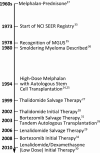Racial disparities in incidence and outcome in multiple myeloma: a population-based study
- PMID: 20823456
- PMCID: PMC3031400
- DOI: 10.1182/blood-2010-07-298760
Racial disparities in incidence and outcome in multiple myeloma: a population-based study
Abstract
Multiple myeloma (MM) is the most common hematologic malignancy in blacks. Some prior studies suggest inferior survival in blacks; others suggest similar survival. Using the original 9 Surveillance, Epidemiology, and End Results registries, we conducted a large-scale population-based study including 5798 black and 28 939 white MM patients diagnosed 1973-2005, followed through 2006. Age-adjusted incidence rates, disease-specific survival, and relative survival rates were calculated by race, age, and time period of diagnosis. Mean age at diagnosis was 65.8 and 69.8 years for blacks and whites, respectively (P < .001). Incidence among blacks was m twice that among whites; this disparity was greater among patients < 50 years (P = .002). Over the entire study period, disease-specific and relative survival rates were higher in blacks than whites (P < .001). For whites, 5-year relative survival rates increased significantly 1973-1993 to 1994-1998 (26.3% to 30.8%; P < .001) and 1994-1998 to 1999-2005 (30.8% to 35.0%; P = .004). Survival improvements among blacks were smaller and nonsignificant (1973-1993 to 1999-2005: 31.0% to 34.1%; P = .07). We found (1) a younger age of onset among blacks; (2) better survival in blacks 1973-2005; and (3) significant survival improvement among whites over time, with smaller, nonsignificant change seen among blacks, possibly due to unequal access to and/or disparate responsiveness to novel therapies.
Figures





References
-
- Benjamin M, Reddy S, Brawley OW. Myeloma and race: a review of the literature. Cancer Metastasis Rev. 2003;22(1):87–93. - PubMed
-
- Jemal A, Siegel R, Ward E, Hao Y, Xu J, Thun M. Cancer statistics, 2009. CA Cancer J Clin. 2009;59:225–249. - PubMed
-
- Criteria for the classification of monoclonal gammopathies, multiple myeloma and related disorders: a report of the International Myeloma Working Group. Br J Haematol. 2003;121(5):749–757. - PubMed
-
- Kyle RA, Rajkumar SV. Multiple myeloma. N Engl J Med. 2004;351(18):1860–1873. - PubMed
Publication types
MeSH terms
Grants and funding
LinkOut - more resources
Full Text Sources
Other Literature Sources
Medical

